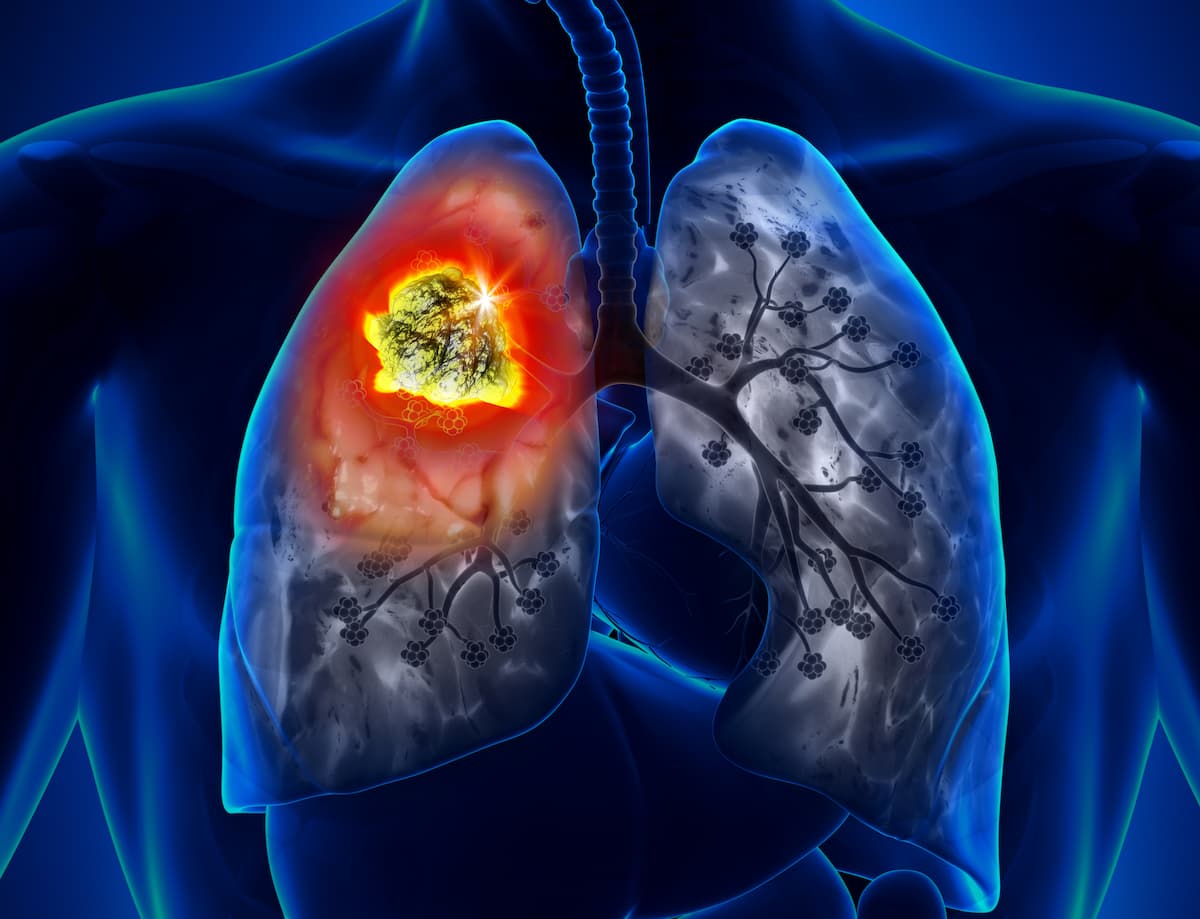European Commission Approves Amivantamab Combo for EGFR-mutated NSCLC
The EGFR-MET bispecific antibody amivantamab in combination with chemotherapy yielded a survival benefit compared with chemotherapy alone for EGFR-mutated NSCLC.
The EGFR-MET bispecific antibody amivantamab in combination with chemotherapy yielded a survival benefit compared with chemotherapy alone for EGFR-mutated NSCLC.

The European Commission has approved a Type II extension for amivantamab (Rybrevant) plus carboplatin and pemetrexed in treat patients with advanced non–small cell lung cancer (NSCLC) with EGFR exon 19 deletions or exon 21 L858R substitutions after EGFR tyrosine kinase inhibitor (TKI) treatment failed to provide clinical benefit, according to a news release from the drug’s developer Janssen-Cilag International.1
Support for the European approval comes from findings from the phase 3 MARIPOSA-2 study (NCT04988295) in which the efficacy and safety of amivantamab was evaluated in combination with chemotherapy vs chemotherapy alone in patients with EGFR-mutated NSCLC variations who did not experience clinical benefit from treatment with osimertinib (Tagrisso).2
Data from the study show the primary end point of progression-free survival (PFS) by blinded independent central review (BICR) was met, with a median PFS of 6.3 months (95% CI, 5.6-8.4) in patients who underwent treatment with amivantamab and chemotherapy vs 4.2 months (95% CI, 4.0-4.4) with chemotherapy alone (HR, 0.48; 95% CI, 0.36-0.64; P < .001).
“While much progress has been made in the lung cancer treatment landscape over the past decade, resistance to existing therapies continues to pose a major challenge for patients with advanced or metastatic [NSCLC] harboring EGFR mutations, underscoring the critical need for ongoing innovation,” Antonio Passaro, MD, PhD, medical oncologist of the Division of Thoracic Oncology at the European Institute of Oncology in Milan, Italy, and lead author of the study, said in the news release.1 “The addition of the bispecific antibody amivantamab to chemotherapy offers an important new treatment option for patients with EGFR exon 19 deletions or L858R mutations, progressing on or after osimertinib. In this setting, this combination set the new landmark for overall response rate and reduced the risk of disease progression or death by more than half compared with standard chemotherapy alone.”
The global, randomized phase 3 trial randomly assigned 657 patients 1:2:2. Patients with EGFR-mutated NSCLC were divided into either amivantamab with chemotherapy (n = 131), amivantamab in combination with lazertinib (Leclaza) and chemotherapy (n = 263), or chemotherapy alone (n = 263) between December 2021 and April 2023. Overall, 636 patients were included in the final analysis after 1 in the amivantamab arm and 20 in the chemotherapy arm did not receive treatment.
Dosing across all cohorts occurred in 21-day cycles, with chemotherapy consisting of intravenous pemetrexed at 500 mg/m2 and carboplatin at area under the curve 5 for the first 4 cycles administered at the beginning of each cycle. Intravenous amivantamab was given at 1400 mg or 1750mg for those weighing 80 kg or greater and was given weekly for the first 4 weeks, followed by 1750 mg or 2100 mg for those weighing 80 kg or greater every 3 weeks starting cycle 3. Oral administration of 240 mg lazertinib occurred daily.
Treatment continued until disease progression or lack of clinical benefit. The dual primary end points were PFS via BICR for amivantamab with chemotherapy vs chemotherapy alone and amivantamab in combination with lazertinib and chemotherapy vs chemotherapy alone. Secondary end points included objective response rate (ORR), duration of response (DOR), overall survival (OS), intracranial PFS, and safety, among other evaluation criteria.
ORR for the amivantamab-chemotherapy and chemotherapy alone arms were 64% (95% CI, 55%-72%) and 36% (95% CI,30%-42%), respectively. The median duration of treatment was 6.3 months (range, 0-14.7) and 3.7 months (range, 0-15.9), respectively, with a median follow-up of 8.7 months. Furthermore, the median DOR was 6.9 months for the combination therapy arm (95% CI, 5.5-not estimable) vs 5.6 months (95% CI, 4.2-9.6) for those taking chemotherapy alone.
References
- European Commission approves RYBREVANT® (amivantamab) in combination with chemotherapy for the treatment of adult patients with advanced EGFR-mutated non-small cell lung cancer after failure of prior therapy. News release. Janssen-Cilag International. August 27, 2024. Accessed August 28, 2024. https://tinyurl.com/2unrfx35
- Passaro A, Wang J, Wang Y, et al. Amivantamab plus chemotherapy with and without lazertinib in EGFR-mutant advanced NSCLC after disease progression on osimertinib: primary results from the phase III MARIPOSA-2 study. Ann Oncol. 2024;35(1):77-90 doi:10.1016/j.annonc.2023.10.117